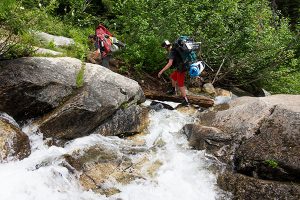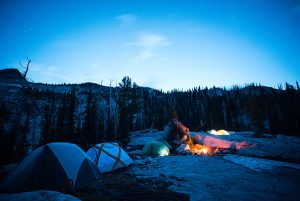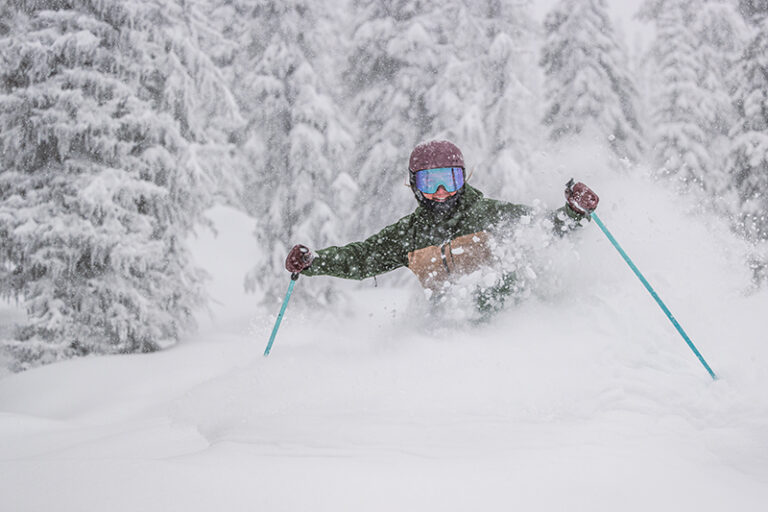It wasn’t until the night before the trip that I started to think about the feasibility of what I had planned. My girlfriend Carly and I were organizing our gear and starting to load our packs. Inside went the normal items: tent, sleeping bags, pads, and food. The big challenge was fitting two inflatable stand up paddleboards onto my pack. With the straps at their max length, I struggled to click each buckle. Once they were latched, I stepped away feeling accomplished. Then I tried picking it up. I managed to hoist it onto the couch and slip my arms into each strap. With a big exhale, I stood up. The pack was almost 90 pounds and 4 feet wide. It largely overshadowed my 5-foot-10, 150-pound frame. Observing this spectacle, Carly asked, “Why are you doing this?” It was a simple question that only the trip ahead could resolve.
If you’ve ever hiked to an alpine lake, you have experienced the serene landscape and stunning quietness only rivaled by a Bob Ross painting. Every summer I add as many new alpine lakes to my weekends as possible, looking for fresh views and a new favorite spot. I was looking for a change of perspective. Paddleboarding is a new sport for me, and I instantly connected with the soulful vibe and sleek glide of the stand up paddleboard. Paddleboarding can transform a noisy place, such as the downtown stretch of the Spokane River, into a lush and peaceful experience. What would it be like to combine the relaxing essence of SUP with the alpine experience?

The hike to Beehive Lake in the Selkirk Mountains starts with a steady grade as you climb out of the Pack River valley, and it doesn’t let up until you see water. At mile 3, fatigue was setting in, and I was beginning to question the trip. Those thoughts were quickly cast away as we navigated from cairn to cairn along the granite slabs for the last mile of trail. Adrenaline kicked in as the anticipation for the lake overpowered my shaking legs. The first glimpse of the lake revealed perfect crystal sparkles reflecting off the water, with snow lining the slopes leading up to Twin Peaks above. We quickly locked down a tent site and inflated the paddleboards.
The crisp, clear water looked inviting, but it hit with a cold, sharp sting as our feet stepped into the shallow water. I pulled myself onto the board and paddled out. My tired legs struggled to find balance. I had become accustomed to the heavy weight from my pack, so the weightless glide across the water couldn’t have been a bigger relief. Circumnavigating the lake, the paddleboard provides an intimate perspective. Below, the fish scatter with the dip of each paddle stroke. Ahead, 7,500-foot peaks rise into the sky. Behind, the reflection of trees ripple at the outlet of Beehive Lake.

Unlike hiking through a forest, being on the water provided open space that gave perspective to our surroundings. The answer to Carly’s question now became clear. Hiking in with paddleboards was a struggle, but it provided complete immersion into the scenery. I wasn’t just a set of eyes viewing it from the sidelines, I was in the landscape. Changing my viewpoint was as painless as a single stroke. Bright boulders of granite and green larches swiftly passed. The ability to move this easily without any impact, excessive effort, or discomfort was unimaginable before this point. My normal routine when arriving at a lake is to drop the pack and take off for the highest peak I can see. While I still love summiting mountains, the tranquility of experiencing the lake via paddleboard was remarkable and worth every step.
The right gear can make or break a trip like this. I rented two paddleboards from Stillwater Outdoors in Spokane. They make their paddleboards for people looking to adventure beyond the end of the road. The paddleboards come in a backpack with everything you need for a float, making it easy and quick if you plan to take them out on a day hike. Don’t venture farther than you have before without paddleboards, because the boards add weight and increase the exhaustion level. Consider taking them for a trial day hike before committing to an overnight trek. Lastly, consider the probability that you will become hooked and find yourself purchasing a board in the near future. I know I will. //
Skye Schillhammer is a freelance photographer and bike shop employee at the Bike Hub in downtown Spokane. He wrote about how to jump a bike in May.













